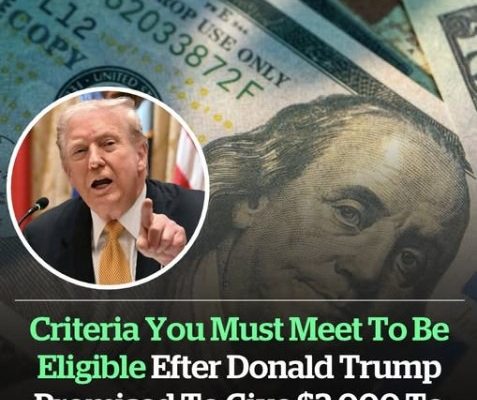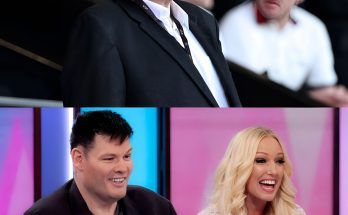When Donald Trump jumped onto Truth Social this week and declared that Americans would soon receive a $2,000 “dividend,” the announcement exploded across the country. Supporters called it bold. Critics called it impossible. But one thing was certain: people wanted to know exactly who would qualify and how the money would actually reach them. Trump framed the payout as a reward for what he views as the economic windfall generated by his aggressive tariff strategy. According to him, the tariffs have transformed the United States into “the richest, most respected country in the world,” with soaring markets, healthier retirement accounts, and a long-awaited chance to start paying down the national debt.
“This is all because of Tariffs,” Trump wrote. “People who oppose them are FOOLS. We are taking in trillions. The country has never been stronger.”
The promise was blunt: $2,000 for “almost everyone.” But once his economic team began speaking publicly, the picture grew more complicated.
Treasury Secretary Scott Bessent, who has quickly become one of the main architects of Trump’s economic messaging, hinted that the payments wouldn’t be universal. In an interview on Fox & Friends, he floated the first real eligibility guideline: families earning under $100,000 a year would likely make the cut. His phrasing wasn’t definitive, but it was deliberate. The administration is still arguing internally over the income ceiling, though Bessent signaled the president is leaning toward a broad payout rather than a narrow one.
“Well, there are a lot of options here,” Bessent said. “The president’s talking about a $2,000 rebate for families making less than, say, $100,000. That’s one model being discussed.”
If that threshold becomes official, nearly 150 million Americans could qualify — almost double the reach of Trump’s earlier stimulus checks, which capped eligibility at $75,000 for single filers and $150,000 for couples. Policy analysts immediately began running the numbers. Erica York from the Tax Foundation estimated that at a $100,000 income cap, the cost balloons to roughly $300 billion. That’s a staggering price tag for any administration, and it raises the question the White House has not answered cleanly: where the money comes from.
Tariff revenue is Trump’s favorite talking point, but the math is unforgiving. As of September 30, total U.S. tariff revenue stood at $195 billion — not even close to what’s needed for a one-time national dividend of this scale. The Treasury Department projects $3 trillion in cumulative tariff income over the next decade, but that projection spreads across ten years and assumes continued tariff increases. Even then, the revenue is already earmarked for other obligations. Using it for a massive cash payout would mean borrowing against future income while the national debt pushes past $38 trillion.
Still, Trump isn’t slowing down. In his view, the tariffs themselves are the engine that will fund this promise. He has doubled down with fresh hikes: 50% taxes on imported cabinets and talk of a 100% tax on branded pharmaceuticals. Trump insists that these tariffs strengthen America’s financial position without harming consumers, a stance economists have repeatedly challenged. But politically, the message is simple: tariffs are paying for America’s comeback, and Americans deserve their share.
While Trump paints the idea as a straightforward stimulus check, Bessent has been walking that back. Speaking to ABC, he made it clear the $2,000 might not take the form of a one-time payment at all. Instead, he hinted at a patchwork of tax adjustments that could add up to the same value across the year.
“It could come in lots of forms,” Bessent said. “No tax on tips, no tax on overtime, no tax on Social Security, deductibility of auto loans. These policies are already helping people, and we’re expanding that.”
He framed these changes as the early stages of Trump’s larger plan — savings that appear gradually on paychecks rather than landing as a single windfall. Supporters argue this approach builds long-term relief instead of a one-shot check. Critics say it buries the promise in confusing tax code gymnastics, making the “$2,000 dividend” more slogan than substance.
White House Press Secretary Karoline Leavitt tried to strike a confident tone when pressed for details. She didn’t offer concrete eligibility rules or a rollout timeline, but emphasized Trump’s commitment to delivering something tangible.
“The president made it clear he wants to make it happen,” Leavitt said. “His team of economic advisers is looking into it.”
Behind the scenes, the administration is juggling two realities. First: Trump publicly committed to sending Americans money — a promise that energizes his base and applies pressure to Congress, economists, and even his own cabinet. Second: actually paying for a program this large forces the White House to confront the limits of tariff revenue, increased borrowing, and the political fallout of adding to the national debt.
The tension between those realities is already visible in the way Bessent speaks about the plan. He knows the math. He knows tariffs alone won’t cover it. So he shifts the focus from checks to tax cuts, from an immediate payout to a blended approach that stretches across the year. This gives the administration flexibility. If the numbers don’t add up, they can claim the $2,000 arrived indirectly through tax relief rather than through a direct deposit.
Meanwhile, Trump continues framing the checks as a symbol of national strength — a kind of victory dividend funded by America’s assertive economic posture. He talks about tariffs not as a burden but as proof that the U.S. finally has leverage again.
“We are the richest, most respected country in the world,” he wrote. “And this is only the beginning.”
Whether that’s political bravado or an economic plan with real legs is still unclear. Until the White House announces the final eligibility rules, Americans are left watching the back-and-forth between bold promises and the messy reality of federal budgeting.
One thing is certain: if the threshold lands at $100,000, nearly half the country will qualify. If the payout comes as a blend of tax breaks rather than a check, millions may not realize when — or how — their “dividend” shows up. And if tariff income falls short, the administration will have to choose between reducing the payout, borrowing heavily, or shifting the cost to future budgets.
For now, all the country has is a promise, a handful of interviews, and a White House scrambling to make the numbers line up behind the scenes.
The president says the money is coming. His team insists they’re working on it. And the rest of America is waiting to see whether this becomes a major economic policy — or another headline built on hype.



